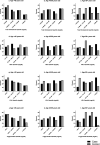Association of lipid profile biomarkers with breast cancer by molecular subtype: analysis of the MEND study
- PMID: 35739205
- PMCID: PMC9226351
- DOI: 10.1038/s41598-022-13740-x
Association of lipid profile biomarkers with breast cancer by molecular subtype: analysis of the MEND study
Abstract
There is conflicting evidence on the role of lipid biomarkers in breast cancer (BC), and no study to our knowledge has examined this association among African women. We estimated odds ratios (ORs) and 95% confidence intervals (95% CI) for the association of lipid biomarkers-total cholesterol, high-density lipoprotein (HDL), low-density lipoprotein (LDL), and triglycerides-with odds of BC overall and by subtype (Luminal A, Luminal B, HER2-enriched and triple-negative or TNBC) for 296 newly diagnosed BC cases and 116 healthy controls in Nigeria. Each unit standard deviation (SD) increase in triglycerides was associated with 39% increased odds of BC in fully adjusted models (aOR: 1.39; 95% CI: 1.03, 1.86). Among post-menopausal women, higher total cholesterol (aOR: 1.65; 95% CI: 1.06, 2.57), LDL cholesterol (aOR: 1.59; 95% CI: 1.04, 2.41), and triglycerides (aOR: 1.91; 95% CI: 1.21, 3.01) were associated with increased odds of BC. Additionally, each unit SD increase in LDL was associated with 64% increased odds of Luminal B BC (aOR 1.64; 95% CI: 1.06, 2.55). Clinically low HDL was associated with 2.7 times increased odds of TNBC (aOR 2.67; 95% CI: 1.10, 6.49). Among post-menopausal women, higher LDL cholesterol and triglycerides were significantly associated with increased odds of Luminal B BC and HER2 BC, respectively. In conclusion, low HDL and high LDL are associated with increased odds of TN and Luminal B BC, respectively, among African women. Future prospective studies can definitively characterize this association and inform clinical approaches targeting HDL as a BC prevention strategy.
© 2022. The Author(s).
Conflict of interest statement
The authors declare no competing interests.
Figures
References
-
- Newman LA, Jenkins B, Chen Y, Oppong JK, Adjei E, Jibril AS, et al. Hereditary susceptibility for triple negative breast cancer associated with western sub-saharan african ancestry: Results from an international surgical breast cancer collaborative. Ann. Surg. 2019;270(3):484–492. doi: 10.1097/SLA.0000000000003459. - DOI - PubMed
Publication types
MeSH terms
Substances
Grants and funding
LinkOut - more resources
Full Text Sources
Medical
Research Materials
Miscellaneous



